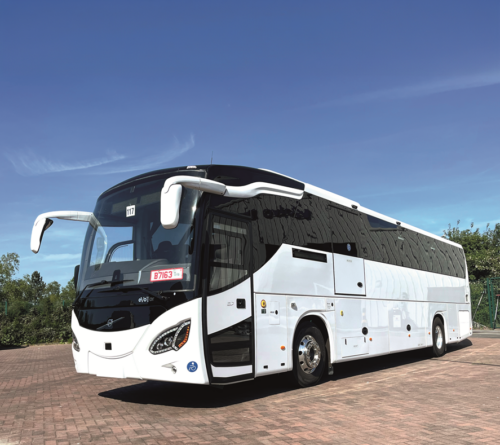
Adrian Morton casts his expert eye over the new Volvo B8R MCV eVoTor and gives an operator’s perspective of the marque’s new mid-range coach offering
Five years after the MCV eVoTor took to the roads in the UK on Volvo’s B11R chassis, the first four with revised frontal styling and built on the Volvo B8R are now starting to hit the streets. Volvo took the decision to change production to the B8R chassis, so it is no longer an option in the UK for the body to be specified on the B11R.
The eVoTor, although not yet sold in huge quantities, has become a familiar sight on the country’s roads, more obvious probably due to its distinctive frontal styling which is not in any way similar to comparable products on the market. The body consists of a stainless steel frame with panels a mix of stainless steel and GRP mouldings. The revised styling is not significantly different to that offered on the B11R; in fact, you’d probably be hard pressed to notice the difference. In essence it’s just a little flatter with headlights less defined. I’m unsure of the reasoning but it will certainly aid cleaning, particularly by drive-through washes.
Continuing with the frontal theme, the windscreen is a laminated one piece bonded unit with the rest of the front-end structure below comprising five separate panels, which makes repairing any collision damage easier and far more cost effective. Mirrors are the popular electrically controlled and heated Mekra units which are robust, offer good all-round vision, are easily obtainable and won’t break the bank as do so many of the alternatives.
Moving around to the nearside, the front door is a common single-piece plug type leading to the entrance. A 48-litre AdBlue tank is located immediately ahead of the nearside front wheels, which is a common position when compared to other manufactures; the only downside is the necessity that the front passenger door has to be closed in order to access the filler, but that’s no real detriment.
Located above the front wheel, the coach has the added benefit of having a fuel filler on both sides for added convenience. Tank volume is a respectable 480 litres and Volvo’s now standard push fillers make the process easy, with no awkward caps to contend with. Behind this we have two manually operated cantilever doors for the lockers. As a former operator I’ve always favoured both of these options. Parallel-opening lockers are easier to use in confined spaces and are far less likely to be torn off, and electrically operated ones are just more to go wrong.
[…]By subscribing you will benefit from:
- Operator & Supplier Profiles
- Face-to-Face Interviews
- Lastest News
- Test Drives and Reviews
- Legal Updates
- Route Focus
- Industry Insider Opinions
- Passenger Perspective
- Vehicle Launches
- and much more!


